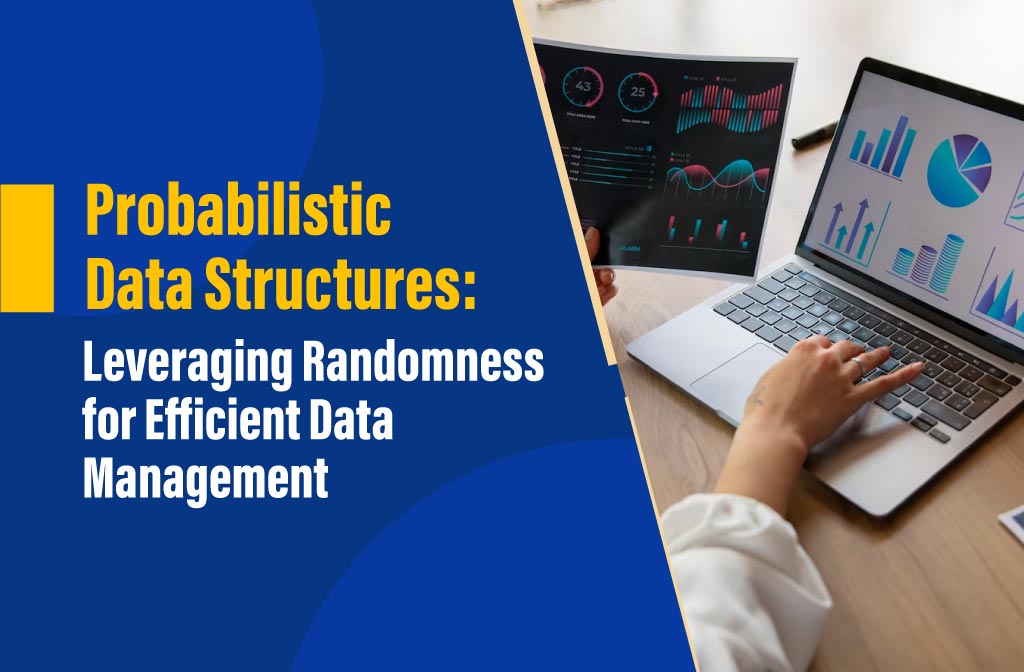
Did you hear about how probabilistic data structures are? It is a kind of decision to make between accuracy and efficiency in terms of memory and computing cost that is made by algorithms or data structures that intend to provide approximate answers.
Probabilistic decisions compromise reliability to provide efficiency and flexibility, unlike standard data structures, which seek precise and deterministic results. It performs well when dealing with large data sets, whereas the traditional approaches focus on resource-intensive approaches. It consumes less memory and processing power than reliable yet offers approximations with controlled rates of error. Probabilistic data structures are interesting. In this article, you can read about the commonly utilized probabilistic data structures, advantages, and limitations.
Overview of probabilistic data structures:
Bloom filter:
- Probabilistic data structures are required to locate missing elements in a data collection. It is used to test the approximate accuracy of data sets.
- It is an m-bit array with a starting value of zero. The elements of this array are added by entering them into its k hash functions, which define the array’s values and the location of the k array.
- To check whether certain elements from a collection are present or not, use the K hash function.
- The bit location of an element indicates whether or not it is part of the set when it is 0. A bit in position 1 denotes that there is a possibility that a specific element will be discovered in the collection.
- Counting Bloom filters, distributed Bloom filters, layered Bloom filters, and more are examples of further Bloom filter types.
Hyper Log
The number of distinct elements in a set is determined by a probabilistic or streaming data structure. With only 1.5KB of memory used, the massive data collection can count one billion different components with 2% accuracy. This data structure uses less memory and provides appropriate correctness.
Sketch using Count-Min:
It uses a probabilistic streaming data structure to count the frequency of each element in a stream. The count-min sketch may determine an element’s frequency in O(k) time. The ADD operation is used to carry out union activity.
This data structure can result in overestimating the components but not undercounting them, despite having high accuracy. This data format uses streaming probabilistic data.
Advantages of probabilistic data structures:
The following are the notable advantages that include:
- It can manage an enormous amount of data, making it beneficial for big data applications.
- They are more memory-efficient than typical data structures since they are designed to fit into small spaces.
- Perfect for use in real-time applications, it generates approximations of answers to queries.
- In contrast to exact approaches, this generates predictions of the answers using encryption and randomization.
- Due to its simplicity of development, this is available to a wide range of developers and use cases.
- Probabilistic data structures allow an alternative between accuracy and efficiency, allowing for an optimal balance between the two that may be tailored to specific applications.
Limitations of probabilistic data structures:
The above explanation makes it evident that probabilistic data structures have advantages for large data sets, and as the number of data sets increases, the necessity for them increases. Due to these data structures’ solid mathematical and logical characteristics, Google’s Guava and Twitter’s Scala libraries both use them. Probabilistic data structures are more effective and consume less memory and time when answering queries on large data sets. However, here are some limitations of this data structure you need to know:
- Probabilistic data structures prioritize effectiveness and flexibility above precise accuracy. Recognize the limitations that are given, such as the likelihood of errors or false positives. Consider your use case and the degree of error you can accept before selecting the right data structure.
- Many probabilistic data structures require the setting of parameters, such as accuracy, error rates, and memory allocation. While balancing the differences between accuracy and memory utilization, consider your specific requirements. You should experiment with these variables until you find the ideal balance for your application.
- Even though probabilistic data structures grow effectively and are useful for handling large datasets, it’s crucial to keep track of performance and resource consumption as your data grows.
Conclusion:
Probabilistic data structures are widely used in applications like security networks, database management, and data analytics. As a computer engineer pursuing a career in any of the top 5 engineering colleges in Coimbatore, look forward to learning and experimenting more in the world of programming. The data structure career is for you. In today’s times, employers are looking for candidates who can write effective, clear code and have strong problem-solving skills. Technical interviews are common during recruitment at major technology companies like Google or Facebook. In these interviews, algorithmic problem-solving is commonly used. Learning about data structures and algorithms will boost your confidence and help you get your foot in the door.















